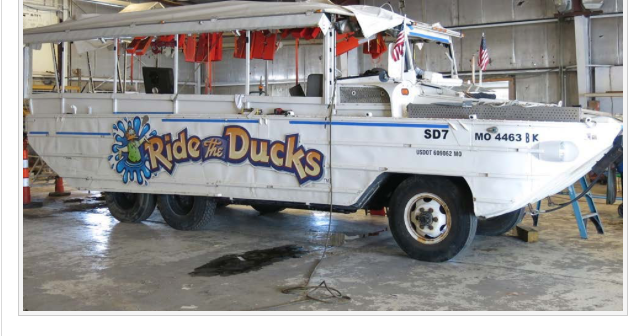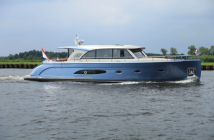The National Transportation Safety Board just issued a report that spread the blame for the tragic sinking of a duck boat two years ago on a Missouri lake, killing 17 people, among the company that ran the tourist duck boat fleet there, the Coast Guard, and the design of the boat itself.
The basic problem, the NTSB said, was that Ripley Entertainment Inc, which ran the Ride the Ducks operation in Branson, Missouri, should have shut down operations after receiving a severe thunderstorm warning before Stretch Duck 7 entered Table Rock Lake with 29 passengers and a crew of two on July 19, 2018. The boat was a 33-feet-long modified World War 2 amphibious craft that gave tours on land before entering the lake.
“Had Ride the Ducks employees taken more appropriate actions and made better decisions, it is likely the duck boat would not have sunk because they would not have continued operations based on the weather forecast and prevailing conditions,” said Robert Sumwalt, the NTSB chairman.
The National Weather Service issued a severe thunderstorm watch for the area several hours before the sinking, and had upgraded it to a severe thunderstorm warning before Stretch Duck 7 left the boarding area six miles from the lake. At 1832 the weather service advised that 6o-mph winds could hit the lake. Stretch Duck 7 entered the water at 1855.
About five minutes later the leading edge of a storm passed through, with wind gusts up to 73 mph and waves 3- to 5-feet on the lake. Stretch Boat 7 headed for shore, and sank about 250 feet from the exit ramp, killing 16 passengers and one crew member.
The boat had design problems. Waves flooded in through a non-weathertight air intake hatch on the bow, causing it to sink, according to the NTSB. And, the report said, the Coast Guard contributed to the sinking by failing to require sufficient reserve buoyancy on the duck boats. Stretch Duck 7 had low freeboard, an open hull, and not enough reserve buoyancy. And when it started to sink, the fixed overhead canopy and a closed curtain on the starboard side impeded the passengers’ escape routes.
The boat’s captain, Kenneth Scott McGee, never told the passengers to put on life jackets. Oddly enough, the NTSB said that if they had, more people might have died because the jackets’ flotation would have forced them up, trapping them against the canopy. Capt. McGee was later charged with 17 counts of misconduct, negligence and inattention to duty.
But the main culprit here, according to the NTSB, was Ripley. The NTSB report said the probable cause of the sinking was Ripley’s “continued operation of waterborne tours after a severe thunderstorm warning was issued for Table Rock Lake, exposing the vessel to a derecho which resulted in waves flooding through a non-weathertight air intake hatch on the bow.
“Contributing to the sinking was the Coast Guard’s failure to require sufficient reserve buoyancy in amphibious vessels. Contributing to the loss of life was the Coast Guard’s ineffective action to address emergency egress on amphibious passenger vessels with fixed canopies, such as the Stretch Duck 7, which impeded passenger egress.”
The NTSB actually had some kind words for Captain McGee, who said he found himself in the water, struggling to stay afloat, until someone saved him by pulling him aboard another tourist boat. “It is likely that the captain believed he could safely complete the waterborne portion of the tour before the thunderstorm arrived,” the NTSB said. “The captain’s decision to head toward the exit ramp when encountering the severe weather was appropriate.” Read the NTSB report here:
https://www.ntsb.gov/news/events/Documents/DCA18MM028-BMG-abstract.pdf
https://www.ntsb.gov/news/press-releases/Pages/NR20200428.aspx




